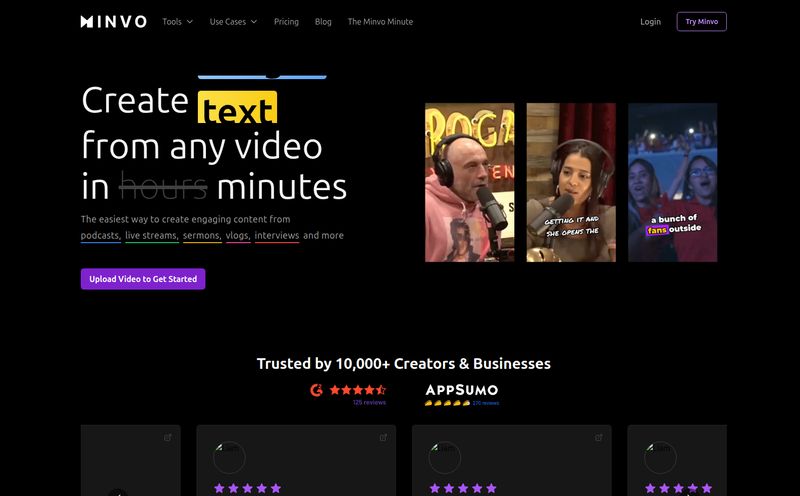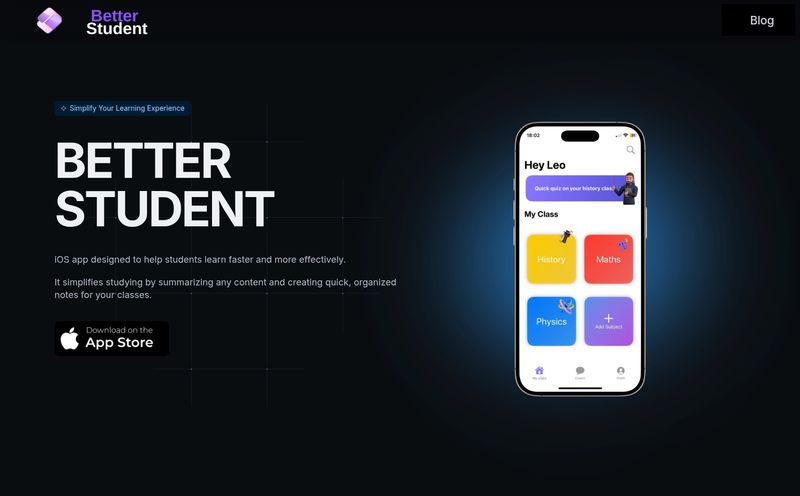I’ve been in this SEO and content game for a while. Long enough to remember when “going global” with video meant one of two things: painstakingly adding subtitles that half your audience would ignore, or selling a kidney to afford a professional dubbing studio. The dream was always there, right? You create this amazing video, this piece of content you’ve poured your heart into, and you just know it could find an audience in Brazil, or France or South Korea. But the barrier was always a massive wall of time and money.
Then AI came along. First, it was clunky text-to-speech bots that sounded like a depressed Stephen Hawking. We all had a laugh, but it wasn't serious. But lately… things have been changing. Fast. The tech is getting scarily good. And that’s what led me to stumble upon a tool called Speax. It promises AI-powered dubbing with lip-sync, and my inner content strategist, the one who’s always chasing traffic and trends, sat up and paid attention.
So, is it just another shiny object, or is it a genuinely useful tool for creators? Let's get into it.
First Off, What Exactly is Speax?
In simple terms, Speax is a platform that takes your video, listens to what you're saying, and then re-creates the audio in a different language, using a surprisingly natural-sounding AI voice. But here’s the kicker it also tries to match the new audio to your on-screen lip movements. This isn't just a simple voice-over; it's a full-on attempt at digital dubbing.
Think of it like having a team of multilingual voice actors and a video editor on standby, only they’re all packed into an algorithm. You upload your video, pick your target language, and let the AI do its thing. For any creator who's stared at their YouTube analytics and dreamed of breaking into a new geographical market, the concept alone is pretty exciting.

Visit Speax
The Features That Actually Matter
A tool can have a million features, but only a few usually make a real difference in your workflow. After playing around, here’s what stood out to me about Speax.
The AI Dubbing and Voice Cloning
This is the core of the whole platform. The quality of the AI voices is, frankly, impressive. They've moved beyond that robotic monotone we all associate with AI. There's inflection, a more natural cadence, and a general warmth that was missing from older tech. The voice cloning feature is particularly interesting. The idea is that it can learn your own voice and then have it speak another language. I’ve seen this tech elsewhere, and when it works, it’s magic. It keeps your brand's auditory identity intact, even across language barriers.
The Lip-Sync Holy Grail
Okay, let's be real. Bad lip-sync is distracting. It’s that classic, terribly dubbed kung fu movie effect. It pulls you right out of the experience. This is where most automated solutions fall flat on their face. Speax's lip-sync technology is its boldest claim, and I have to say, it’s a solid attempt. It's not going to fool a Hollywood director, but is it good enough for a YouTube tutorial, a corporate training video, or a social media ad? Absolutely. It turns a disconnected voice-over into a much more believable performance. It’s the difference between a puppet with a static mouth and one whose mouth actually moves with the words. A game-changer for viewer engagement.
Going Global with Multilingual Support
A dubbing tool isn't much use without a good library of languages. Speax supports a range of languages, which is obviously critical for its entire purpose. Being able to process a single video and get back versions for Spanish, German, and Portuguese-speaking audiences in a matter of minutes instead of weeks is… well, it’s the kind of efficiency I wish I had ten years ago. It opens up SEO opportunities we barely considered before, like ranking for your core keywords in entirely new regions.
The Little Things: Batch Processing and Music Preservation
These are the quality-of-life features that show the developers understand a creator's workflow. If you have a whole series of videos, being able to upload and process them in a batch is a huge timesaver. And the fact that it can preserve your background music and sound effects, stripping out only the original voice track, is just smart. It saves you a massive headache in post-production, trying to layer everything back together yourself.
My Experience: The Good, The Bad, and The AI
The interface is clean and straightforward. You don't need a degree in audio engineering to figure it out, which is a massive plus. It’s pretty much an upload-and-go process. But it's not perfect, and anyone who tells you AI is a flawless replacement for human skill is selling you something.
The main thing to understand is that the AI is a brilliant but sometimes quirky assistant. It might misinterpret a word, or the emotional inflection might be slightly off for a specific sentence. My experience is you still need to be the final quality control. You have to watch the output and be ready to do some fine-tuning. This isn't a failure of Speax, but the reality of where AI is in 2024. It gets you 95% of the way there in a fraction of the time, your job is to handle that last 5%.
Also, it requires an internet connection, which seems obvious, but if you're like me and sometimes work on the go with spotty Wi-Fi, it's something to remember. No offline processing here.
So, What's the Price Tag?
This is the million-dollar question, isn't it? As of my last check, Speax's pricing wasn't prominently displayed, which can be typical for newer platforms testing the market waters. Based on similar tools I've seen, I'd anticipate a model based on usage—either per minute of video processed or a monthly subscription with different tiers of features and processing time. For commercial use, there will almost certainly be a cost.
My advice? Don't let the lack of a public price list scare you off. Go to their website, see if there's a free trial or a demo, and get a feel for it yourself. The potential ROI from reaching a new audience could make any reasonable cost a no-brainer.
Who Should Be Using Speax?
This tool feels like it was practically custom-built for a few specific groups:
- YouTubers and Content Creators: The most obvious fit. Imagine easily creating a Spanish or Hindi version of your channel. The potential for audience growth is enormous.
- Marketers: Need to run a video ad campaign in multiple countries? This is way faster and cheaper than coordinating multiple international agencies and voice talents.
- E-Learning and Corporate Trainers: Standardizing training materials across a global company just got a whole lot easier.
Who should maybe hold off? If you're producing a major cinematic feature film destined for the Oscars, you're probably still gonna want a traditional, high-end dubbing studio. For now. But for the 99% of other video content out there? This technology is becoming a seriously viable option.
Frequently Asked Questions about Speax and AI Dubbing
What exactly is Speax?
Speax is an AI-powered software platform designed to automatically dub videos into multiple languages. It uses artificial intelligence to translate the audio, generate a new voice track, and even sync the new audio to the lip movements of the person on screen.
How good is the lip-sync technology?
It's surprisingly good for most use cases like social media, marketing, and online courses. While it might not be perfect enough for a blockbuster film, it's a huge improvement over a standard voice-over and makes the video feel much more natural and engaging for the viewer.
Can I use my own voice for the dubbing?
Yes, Speax includes a voice cloning feature. This allows the AI to learn the characteristics of your own voice and then generate the dubbed audio in different languages but with your vocal identity. It's a powerful feature for maintaining brand consistency.
Is Speax a free tool?
While there may be a free trial or a limited free tier, Speax is a professional tool and will likely have costs associated with commercial or heavy use. Pricing is often based on the amount of video you process. It's best to check their official website for the most current pricing information.
Is AI dubbing better than hiring human voice actors?
It's a trade-off. Human voice actors can provide a level of emotional nuance and performance that AI is still learning to replicate perfectly. However, AI dubbing with a tool like Speax is exponentially faster, more scalable, and more cost-effective. For many content creators and businesses, the speed and cost benefits make AI the superior choice.
Final Thoughts: Is Speax the Future?
Look, I get excited by tech that solves real, tangible problems for people who are actually in the trenches making content. Speax feels like one of those tools. It directly attacks the massive barrier of language that has held so many creators back.
It’s not a magic button. You still need to be the director, the producer, the final say. But it takes what used to be a mountain of work and turns it into a manageable hill. It makes the dream of a truly global audience feel less like a dream and more like a viable marketing strategy. For that reason alone, I think it’s absolutely worth a look. The future of content is global, and tools like this are what will get us there.
Reference and Sources
- Forbes: Content Localization: The Key To Unlocking Global Markets
- TechCrunch: The emerging art of AI voice cloning



